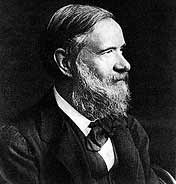

In 1829 Johann Wolfgang Döbereiner (born 1780, died 1849) had noted that there are a number of triads of similar elements in which the atomic weight of the middle element is approximately the average of the other two elements' atomic weights. Among the triads are Chlorine, Bromine, and Iodine; Calcium Strontium, and Barium; Sulfur, Selenium and Tellurium; and Iron, Cobalt and Manganese.
 Despite efforts to systematize the rapid accumulation of chemical facts, much confusion abounded. Friedrich Kekulé for example, in 1860 discussed 19 different proposed formulae for acetic acid!
Despite efforts to systematize the rapid accumulation of chemical facts, much confusion abounded. Friedrich Kekulé for example, in 1860 discussed 19 different proposed formulae for acetic acid!
To find a solution to the confusion Kekulé suggested, and a friend, Karl Weltzien, Professor of Chemistry at Karlsruhe, Germany, organized and conveined in Karlsruhe on 3 September 1860 the first International Chemical Congress. Kekulé, Weltzien and atomic theory advocate Adolphe Wurtz invited participants to spend three days discussing chemical nomenclature, notation and atomic weights. The Congress did determine to base atomic weights on Oxygen (=16 exact) which reacts with more elements than Hydrogen. This would reduce experimental errors in atomic weights. (Atomic weights of elements which don't form compounds were established by combining two measured ratios comparing both to a third element.) But participants at the conference did not reach agreement how correct formulae should be determined. However one of the participants, Stanislao Cannizzaro (b1826, d1910, 1858 sketch at right→) from the University of Genoa distributed reprints of his 1858 course description, proposing a revolutionary concept that eventually solved the confusion.
| Atoms or Molecules | Symbols of the molecules | Numbers expressing their weights |
|
Atom of Hydrogen Molecule of hydrogen Atom of Oxygen Molecule of ordinary Oxygen Molecule of electrised Oxygen, (Ozone) Atom of Sulfur Molecule of Sulphur above 1000¡ (Bineau) Molecule of Sulphur below 1000¡ ... of Water ...of Sulphuretted Hydrogen |
H H2 O O2 O8 S S2 S6 H2O H2S |
1 2 16 32 128 32 64 196 18 34 |
 Cannizzaro (←1870 portrait at left) was born in Palermo, Sicily, and served in the artillery in the 1847 failed Sicilian revolution of independence. On the collapse of the insurgents, Cannizzaro escaped to Marseille in May 1849, and after visiting various French towns reached Paris in October where he met Michel Eugène Chevreul and did some chemical research in his laboratory. Cannizzaro received an appointment as professor of physical chemistry at the National College of Alessandria (50 miles north of Genoa) in 1851. He became professor of chemistry at the University of Genoa in the Fall 1855. At Genoa he formulated his course description of chemical philosophy which he distributed at the International Chemical Congress in 1860. Following the Congress, the 34-year-old Sicilian exile returned to Sicily following Garibaldi's now triumphant conquest. In 1861 was made director of the not-yet-existent University Chemistry Laboratory in Palermo, and he began gathering colleagues and students who were as revolutionary in chemistry and in politics as himself (for example, he advocating higher education for women). Cannizzaro also provided community service (serving on the municipal council, and commissioner of public health). In 1870 he left Palermo for Rome, where he served as Senator and Professor of Chemistry.
Cannizzaro (←1870 portrait at left) was born in Palermo, Sicily, and served in the artillery in the 1847 failed Sicilian revolution of independence. On the collapse of the insurgents, Cannizzaro escaped to Marseille in May 1849, and after visiting various French towns reached Paris in October where he met Michel Eugène Chevreul and did some chemical research in his laboratory. Cannizzaro received an appointment as professor of physical chemistry at the National College of Alessandria (50 miles north of Genoa) in 1851. He became professor of chemistry at the University of Genoa in the Fall 1855. At Genoa he formulated his course description of chemical philosophy which he distributed at the International Chemical Congress in 1860. Following the Congress, the 34-year-old Sicilian exile returned to Sicily following Garibaldi's now triumphant conquest. In 1861 was made director of the not-yet-existent University Chemistry Laboratory in Palermo, and he began gathering colleagues and students who were as revolutionary in chemistry and in politics as himself (for example, he advocating higher education for women). Cannizzaro also provided community service (serving on the municipal council, and commissioner of public health). In 1870 he left Palermo for Rome, where he served as Senator and Professor of Chemistry.
Cannizzaro's course description demonstrated how Avogadro's hypothesis (that equal volumes of different gases contain the same numbers of molecules) actually leads to a consistent set of atomic weights. More precisely, Cannizzaro showed how the atomic weights of elements contained in volatile compounds can be deduced from the molecular weights of those compounds, and how the atomic weights of elements of whose compounds the vapour densities are unknown can be determined from a knowledge of their specific heats. There was not immediate recognition at the Congress of the significance of Cannizzaro's proposal. But upon returning home and reading Cannizzaro's handout, several chemists began using Avogadro's hypothesis to unravel the confusion about formulae and atomic weights and to organize the chemical elements. For his achievements of fundamental importance to atomic theory, Cannizzaro was awarded the Copley Medal by the Royal Society in 1891.


| introduction | Greeks | alchemy | Lavoisier | Dalton | Berzelius | ↑ | spectra | electron | radiation | Bohr | isotopes | synthesis |
| to site menu | Discovery and Naming of Chemical Elements |
chemistry | physics | |||||||||
| created 23 March 2002; addition 30 March latest revision 5 May 2010 |
by D Trapp | |||||||||||